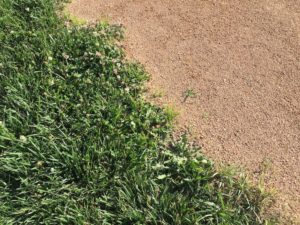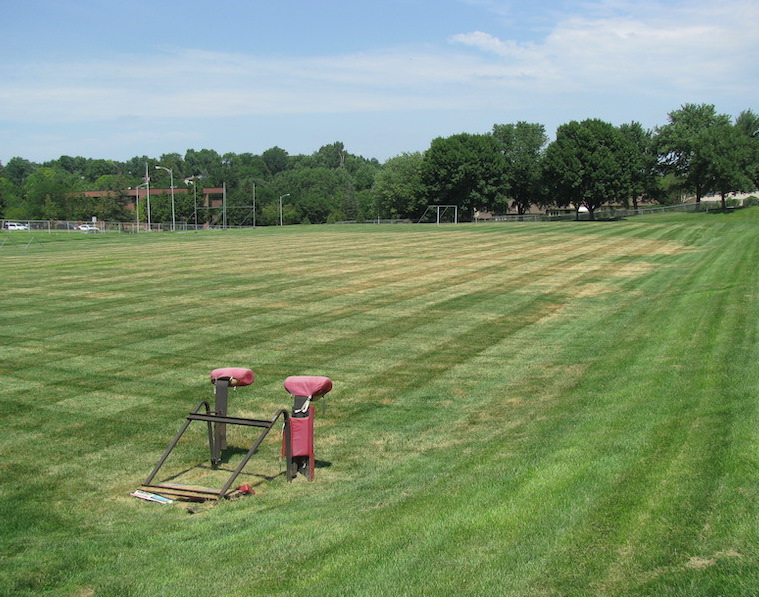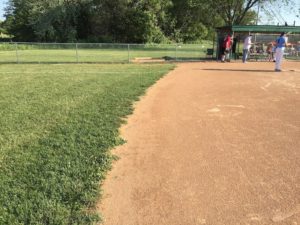By John C. Fech
When boiled down to its essence, a map is a tool for finding something, a group of things or the way to a destination. Maps are pretty important; the old joke about the lazy person who is asked why he is looking for a lost item under the lamppost when he actually lost it a half block away and musing the baseless response of “well, the light is better here,” underscores their value. With a good map, there’s no need to utilize dubious strategies. Finding and controlling weeds with a map is definitely a value-added proposition.
Another aspect of the value of weed maps is that they are useful when a sports field manager is present and when they’re not. When sickness strikes, vacation is taken, or even when management supervision shifts from one person to another, a weed map remains as part of the overall arsenal that can be utilized.
Strategies
During the height of the pandemic, a lot of people spent time watching Netflix and putting puzzles together. Puzzle assembly is a good reminder of a solid overall approach to weed control. Depending on how you count, a weed control puzzle contains between 7 and 10 pieces:

In way too many cases, only one or two of the weed management puzzle pieces are utilized, such as products or certain application specifics. Just as with effective weight loss or smoking cessation programs, the more of these pieces that are implemented, the better.
Scouting
Ok, we know we’re trying to control weeds on sports fields – but where are they? As we begin to put the weed management puzzle together, this is the place to start. Fortunately, most fields are in good enough shape that spotting something out of place can be easily classified as a weed, as opposed to an expanse of bermudagrass or tall fescue.
Two classic methods of scouting exist:
1) Assign a crewmember or group of crewmembers the task of scouting as a major component of their job. These people know that every day, or at least several times a week, they’ll spend some dedicated time to look for knotweed, spurge, dandelions, nutsedge, clover, etc., and making some simple notes about the location and extent of the infestation.
2) Task every crewmember with the duty of “looking all over, all the time.” As they go about their normal routine of mowing, striping, aeration and reseeding, their responsibility is to be observant and notice infestations in various fields.
Monitoring is another term that is often associated with scouting, but it’s not a synonym. Monitoring is a series of scouting events over time, usually a whole season or year of inspections. Both of these approaches can and do work. It’s really just up to the individual sports facility and its leadership to decide which to implement.
Identification
Identification of the target weed is the logical next step. As scouts find groups of plants that are not the desired turf species, identification determines the eventual control procedure(s). Identification can be tricky, requiring experience and training to get it right. Fortunately, there are many very good tools for correctly naming a specific plant, such as the online resources from Purdue University (https://turf.purdue.edu/turfgrass-weeds/) and Texas A&M University (https://aggieturf.tamu.edu/turfgrass-weeds/), and the hardcopy identification guide of Turfgrass Weed Control for Professionals (available at https://mdc.itap.purdue.edu/item.asp?Item_Number=TURF-100 for a nominal fee).

Mapping
A weed map is powerful because it deals with the here and now and the future. As such, it’s both a curative and a preventative tool. In fact, by definition, a weed map identifies where weeds are, where they have been, and provides insight into where they are likely to be in the next growing season.
Map making
Landmarks on a city map (water towers, highways, gas stations, etc.) provide users a sense of where an unknown entity may be. All of these help give context to the location of one thing or another, which is especially useful when going to a particular place for the first time. When documenting the location of weeds on a sports field, it’s really helpful to have landmarks to use as a reference point.
Common landmarks are the interface between infield and outfield, a certain distance from a dugout, and a given yard line on the east or west side of the field.
Several techniques can be utilized, from simple to sophisticated. Some situations call for a physical map, such as a large sheet of poster board mounted in the maintenance shed, using a magic marker to note recent weed outbreaks. When many fields are involved or several weed species are found from year to year, it makes sense to implement an electronic format. A lot of software is available for this purpose, even open source packages. No matter which one is chosen, it’s important that they be common platforms where all workers can gain access and information is safely stored in the Cloud for now and the future.
Map usage
Usage is also known as putting the weeds on the map. Good tools are only as good as how they are utilized. If a cell phone isn’t turned on, none of the powerful features can be accessed. Like hitting the “on” button, the best approach to start using a weed map is to focus on the traditionally stressful locations, such as between the hash marks of a football field, the goal mouth of a soccer field and the sideline areas where the players stand. Weeds such as prostrate knotweed and goosegrass tolerate the compaction of these areas quite well. Once these spots are noted, historic areas of infestation can also be drawn in. A particularly effective approach is to use color to delineate where they are, such as red, green, orange, blue and purple. Bright colors add the dimension of being easy to read and understand quickly.
Rate and label specifics
Read the label – yes, read the label even if you don’t want to and it’s tough to make out the words because of the fine print. It is important to read the label. There are just so many important pieces of information located therein, such as the use of surfactants (or not), the exact amount of product to use, the pH of the water for optimal control, air/soil temperature at the time of application, and watering or avoiding watering after application. Especially with herbicide products, labels often indicated with great detail which weeds are well controlled with an application and which ones are not. Also, when sports fields are adjacent to common areas such as on campus/school/parks grounds, any restrictions on usage are important to note and document on the weed map (or at least on a team member punch list). For example, it might be phrased such as, “Product XYZ can be volatile, so use caution in Field 17 that is close to that row of honeylocust trees on the west side of the bleachers.”
Timing
One of the important pieces of information found on a label is the optimal timing for controlling each target weed. In most cases, the strategy is to try to control weeds in their most vulnerable growth stage:
Broadleaves and sedges – small newly sprouted plants
Warm-season annual grasses and winter annuals – non-emerged seedlings
Focusing on the proper timing avoids the routine of spraying the entire field with curative, postemergence, after-the-fact herbicides. Using information from the map helps direct resources toward the areas of greatest need, saving time and money and usually reducing overall herbicide applications. Weed mapping allows the sports field manager the opportunity to avoid spraying areas of a field where no weeds are present, and restrict spraying to areas already or historically infested.
Cultural practices
Mowing height, fertility level and irrigation amounts are good examples of considerations that intersect or overlap with weed management. Each one influences the effectiveness of control measures, and, in fact, are quasi-control measures themselves.
- Mowing height: The lower the mowing height, the greater the light penetration into the turf canopy and, thus, the germination of weed seedlings. Also, in general, as the height of cut is lowered, the root system is decreased proportionally, which stresses the turf plants, giving opportunistic weeds an advantage for invasion.
- Fertility level: Like mowing height, a sweet spot exists between low fertility and weak, thin turf stands and overly lush topgrowth at the expense of deep, sturdy root systems. Striving for moderate levels of fertility encourages stands that can resist weed invasion.
- Irrigation: The key to effective weed control via irrigation is keep soil moisture on the moist (not soggy or dry) side. Frequently checking various locations on fields with a moisture probe or even a screwdriver helps to determine the timing of the next irrigation event.
Recordkeeping and notes
Documentation, also known as recordkeeping, is an integral part of vehicle maintenance, appliance/HVAC repairs, and, yes, weed management. Think about it; if you don’t know or remember what you did last year, how can you expect to have success this year or next year? The good news is that the notes don’t have to be fancy or exhaustive, just effective.
With facilities that are large and contain sites for several sports, it may make more sense to arrange records and notes field by field than by application. Within each field’s records, subdivisions of notes can be very helpful, such as by month (i.e., April, May, June), groups of weeds (i.e., winter annuals, broadleaves) or specific locations (i.e., left field, dugout). The important feature of a set of records is simply having them. A little experimentation and a lot of flexibility is probably the best approach, knowing that changes and adjustments can always be made if things don’t go exactly to plan.
John C. Fech is a horticulturist with the University of Nebraska-Lincoln and certified arborist with the International Society of Arboriculture. The author of two books and more than 400 popular and trade journal articles, he focuses his time on teaching effective landscape maintenance techniques, water conservation, diagnosing turf and ornamental problems, and encouraging effective bilingual communication in the green industry.



